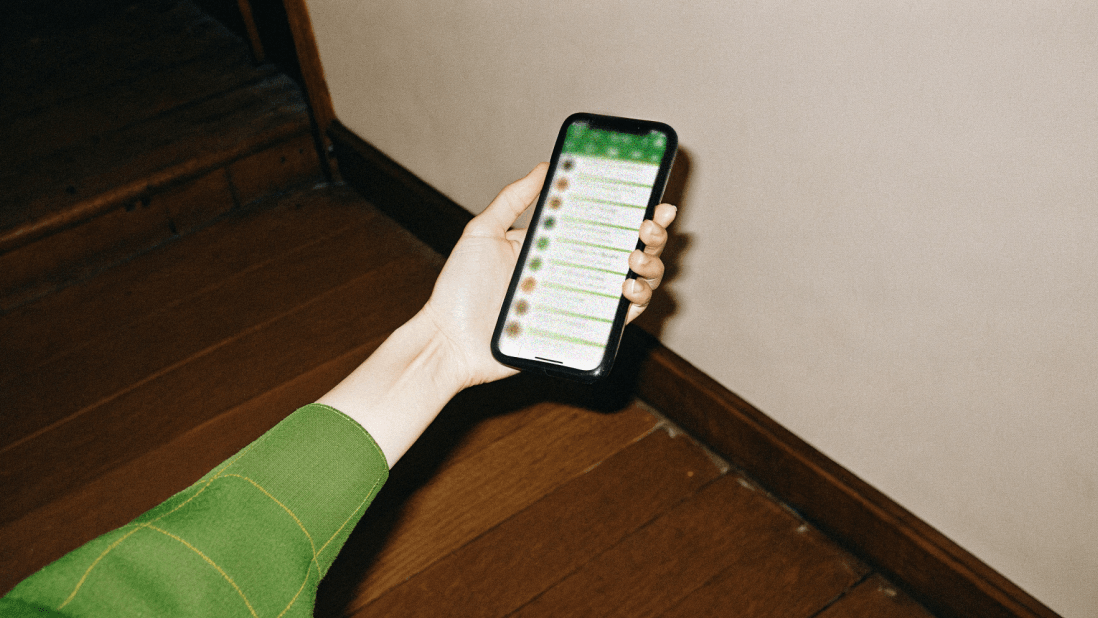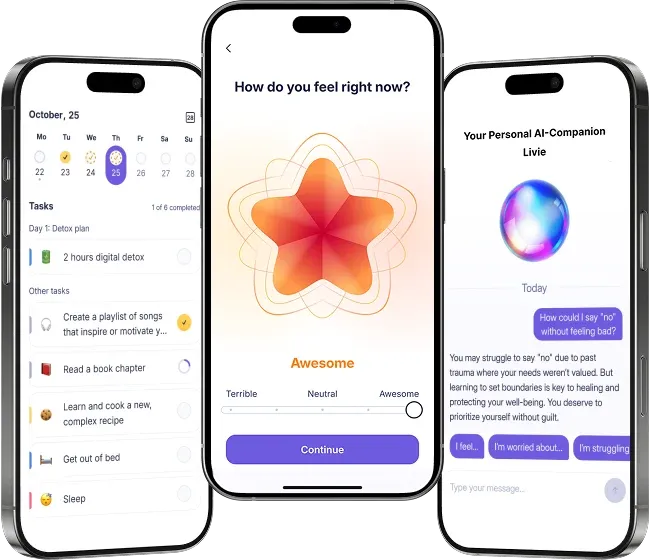Dopamine and Social Media: How to Break the Addictive Loop

Scrolling was never meant to swallow entire evenings, yet here we are opening TikTok “for a minute” and resurfacing long after work, chores, or school responsibilities should’ve been done. You’re not imagining it. The pull of social media is engineered, powerful, and tightly wired into your brain’s reward pathways.
To understand why social media use can feel like an addictive substance and how to break the pattern, we need to look at one thing: dopamine.
Key Learnings
- Social media platforms hijack dopamine release through unpredictable rewards, likes, notifications, and endless streams of content.
Problematic social media use follows a cyclical pattern: anticipation → dopamine hit → crash →
craving → repeat.
- This loop can worsen anxiety, self-esteem issues, and overall well-being.
- You can reclaim control with intentional digital detox strategies, boundaries, and nervous-system regulation.
Why Social Media Feels Addictive
A decade ago, online social networking was something we dipped into occasionally. Now, over 5 billion social network users engage with social networking sites daily, and social media usage continues to rise across all age groups. The psychological literature is clear: these platforms are designed to pull on neural circuitry built for survival, not for endless feeds and autoplay videos.
Dopamine plays a central role here. It isn’t the “pleasure chemical” people often call it; it’s the anticipation molecule. Your brain releases dopamine when it expects something rewarding, such as a message, a like, a new video, or a sudden notification. That anticipation fuels addictive behaviors, even when the actual reward barely satisfies anymore.
This is the exact mechanism involved in drugs and other forms of addiction, but social media has something extra: speed. The brain receives rewards in seconds, and the more dopamine social media triggers, the more dopamine your brain wants.
Briefly: You’re not weak-willed. You’re human, and the system is built to keep you hooked.
The Dopamine–Social Media Connection Explained
Social media platforms rely heavily on positive reinforcement. Here’s what pulls your brain back into the loop:
Likes = Social approval on tap
A single post can deliver an instant rush: validation, attention, connection. Studies show that likes activate the same neural regions involved in real-life social reward. When young age users say they “feel pleasure” from engagement, that's measurable brain activity.
Notifications = unpredictable rewards
Your phone buzzes. Your brain lights up. It’s the exact mechanism that makes slot machines addictive: uncertainty. Will it be good news? A message? A new follower? That unpredictability releases dopamine before you even open the app.
Endless feeds = no natural stopping point
Autoplay, infinite scrolling, rapid-fire videos — these features mimic the Zeigarnik effect, where unfinished tasks stay stuck in the mind. Your brain feels the urge to “complete” the feed, but the feed never ends.
Social pressure = staying “available” 24/7
Modern digital etiquette has changed rapidly. Leaving someone “on read” can feel like a violation of social protocol. This keeps you active, or at least checking on a daily basis.
If you’re looking for tools that support healthier habits instead of feeding addictive loops, explore our guide to the best self-help apps to transform your growth.
The Addictive Loop Explained
Addiction researchers call this a cyclical pattern:
- Anticipation: dopamine levels rise.
- Engagement: you scroll, click, and search.
- Reward: likes, novelty, messages.
- Crash: dopamine drops below baseline.
- Craving: the brain seeks another hit.
- Repeat: often without conscious control.
📝 Research Insight
A national survey from the Teens, Social Media and Mental Health report found that teens who use social media more frequently throughout the day report significantly higher levels of anxiety, depression, interpersonal problems, and conflict in their real-life relationships. The negative impact was most substantial among young age users, especially those who described themselves as unable to cut back or who felt pressure to be constantly online, a pattern linked to psychological dependency and greater dopamine-driven urges to stay connected.
Over time, the brain responds to these patterns by shifting into a state of dopamine deficit, characterized by lower baseline motivation, increased fatigue, heightened urges, and reduced control.
This is why severely addicted users may feel wired but exhausted, connected but lonely, stimulated but unable to focus.
What Science Says About Dopamine and Social Media Addiction
Social media isn’t addictive by accident. It taps into ancient brain systems that evolved to help us survive. When modern algorithms meet these, the result is a loop that’s hard to break.
Here’s the core idea:
- Your brain is wired for social belonging, novelty, and quick information scanning.
- Social networking sites constantly activate these instincts.
- Dopamine rises in anticipation of rewards (not just when rewards appear).
- Unpredictable rewards (likes, notifications, surprises) release more dopamine than predictable ones.
- This reinforcement pattern trains the brain to automatically seek social media.
Social media interacts with dopamine through a mechanism called prediction error, which is the gap between what you expect and what you actually get.
When you get more than expected:
- Dopamine spikes.
- You feel a sudden surge of pleasure.
- The brain learns that the action (checking the app) is worth repeating.
When you get less than expected:
- Dopamine drops below baseline.
- You feel a dip: boredom, restlessness, apathy.
- Your brain starts craving another check to recover.
Over time:
- This fluctuation can lead to a state of dopamine deficit.
- Baseline motivation decreases.
- Cravings increase.
- The loop becomes habitual, which is a form of psychological dependency.
Why Your Brain Prefers Endless Feeds (Evolutionary Explanation)
Humans evolved to be curious because curiosity helped our ancestors survive and thrive. Endless feeds hijack that instinct by offering constant novelty: a new face, a surprising video, a headline, a joke. Each swipe carries the possibility of discovery, which keeps the brain alert and leaning forward. The problem is that this evolutionary wiring meets a digital environment with no natural stopping points. The result is a cycle that feels normal but slowly drains well-being, increases anxiety, and nudges real-life relationships into the background as digital rewards arrive faster and more frequently than in-person experiences.
Endless feeds work because:
- Novelty activates reward pathways instantly.
- Each swipe holds the promise of something interesting.
- Uncertainty keeps the brain alert and drives it to seek more.
- The “next swipe might be better” effect mirrors how slot machines reinforce behavior.
The result:
- A cyclical pattern that feels natural but drains well-being.
- Increased anxiety and emotional fatigue.
- Lower self-esteem from constant comparison.
- Genuine life relationships are pushed aside because digital rewards arrive faster.
Your brain is reacting exactly as evolution designed it to. The trick is learning boundaries that modern platforms don’t naturally encourage.
Psychological and Physical Health Impact
Problematic social media use affects far more than your screen time. Here are some of the most common ways it can impact your well-being:
- Anxiety and FOMO
When dopamine signals “pay attention,” the nervous system enters a state of vigilance. A constant state of alertness can keep the brain in a persistent low-grade stress state, which is linked to anxiety. - Self-esteem erosion
Research suggests that comparing your life to curated online perfection can erode self-esteem, particularly on visual social media platforms, and increase depression risk. - Attention and cognitive drift
Fast, high-novelty content weakens your brain’s ability to maintain focus. Cognitive scientists warn that quick-swipe formats may reduce attention span and interfere with deep thinking. - Ignoring real-life relationships
Social media increases the illusion of closeness while weakening in-person social skills. A healthy relationship needs real presence, not just emoji reactions. - Physical health decline
More sitting, more late-night scrolling, more disrupted sleep. Over time, this affects overall well-being and health.
If you want to understand how dopamine shapes your ability to focus, stay motivated, and follow through on tasks beyond social media, read our guide on dopamine and productivity.
How to Break the Loop: Practical Strategies
Digital detox doesn’t have to be dramatic. What matters is interrupting the dopamine loop and rebuilding balance in your brain.
- Limit screen time.
Set caps for daily usage. Even noticing the urge to “ignore limit” builds awareness of addictive behavior. - Turn off notifications.
This alone can drastically reduce anxiety and addictive use. Silence everything that isn’t essential for safety or close relationships. - Use grayscale mode.
Removing color from your smartphone can make it visually dull, and research shows that reducing the visual salience of apps can decrease engagement and help interrupt problematic smartphone use. - Take real-world breaks.
Walking outdoors, engaging your senses, and reconnecting with your body calms the neural circuitry that drives urges. - Meditate or practice mindfulness.
These practices help regulate our nervous systems, allowing the brain to shift out of autopilot. - Delete apps temporarily.
Anna Lembke, author of Dopamine Nation, recommends at least 24 hours of abstinence to reset your dopamine levels, and ideally a more extended period. Many find that even one week significantly reduces cravings.
Create space for hobbies, movement, relationships, boredom, and rest. All these create protective layers against addictive behaviors.
💡 Tip: If you want a structured way to build healthier habits, get your personalized dopamine management plan, a step-by-step guide tailored to your patterns.
Finding Balance with Social Media
Social media isn’t inherently harmful, but the way it manipulates dopamine can shift from helpful connection to addictive behavior quite quickly. You don’t need a month-long digital detox to change your life. You need awareness, boundaries, and a healthier relationship with your phone.
Choose depth over dopamine hits. Choose people over feeds. Choose real life over compulsive scrolling. Your brain will thank you.
References
- Harvard Medical School. (2024). How social media affects the brain’s reward pathways. https://www.health.harvard.edu
- Liţan, D. E. (2025). Online captive: The impact of social media addiction on self-esteem, anxiety, and depression. Behavioral Sciences, 15(4), 481. https://doi.org/10.3390/bs15040481
- Pew Research Center. (2025, April 22). Teens, social media, and mental health. https://www.pewresearch.org/internet/2025/04/22/teens-social-media-and-mental-health/
- Samra, A., Syed, S. H., Nauman, U., & Ayub, N. (2022). Social comparisons: A potential mechanism linking social media use and negative psychological outcomes. Frontiers in Psychology, 13, 929524. https://pmc.ncbi.nlm.nih.gov/articles/PMC9295248/
- Schneider, F. M., & Walther, E. (2022). Reducing problematic smartphone use: Applying the attention restoration theory and salience reduction approach. International Journal of Mental Health and Addiction. https://link.springer.com/article/10.1007/s11469-022-00826-w

